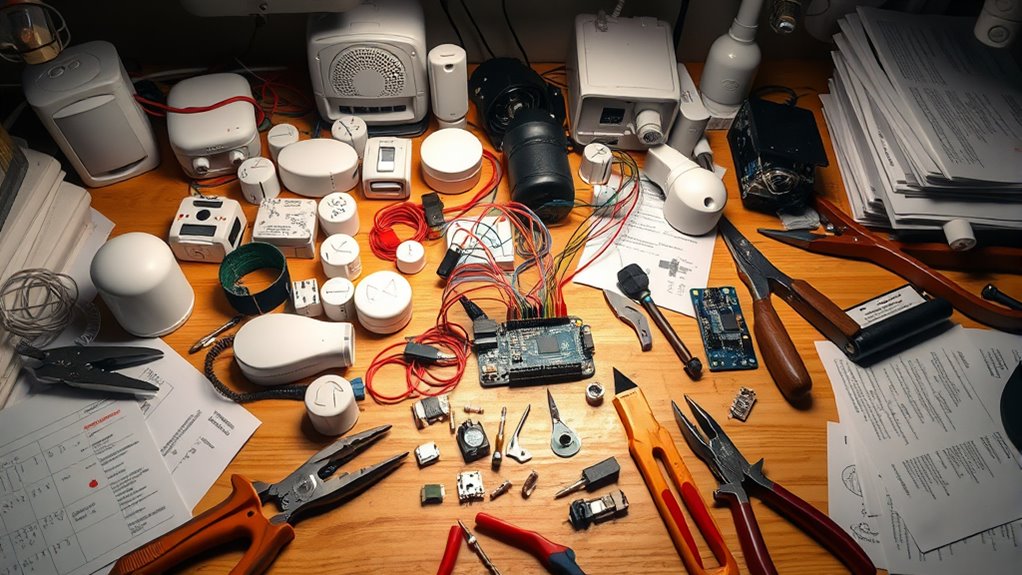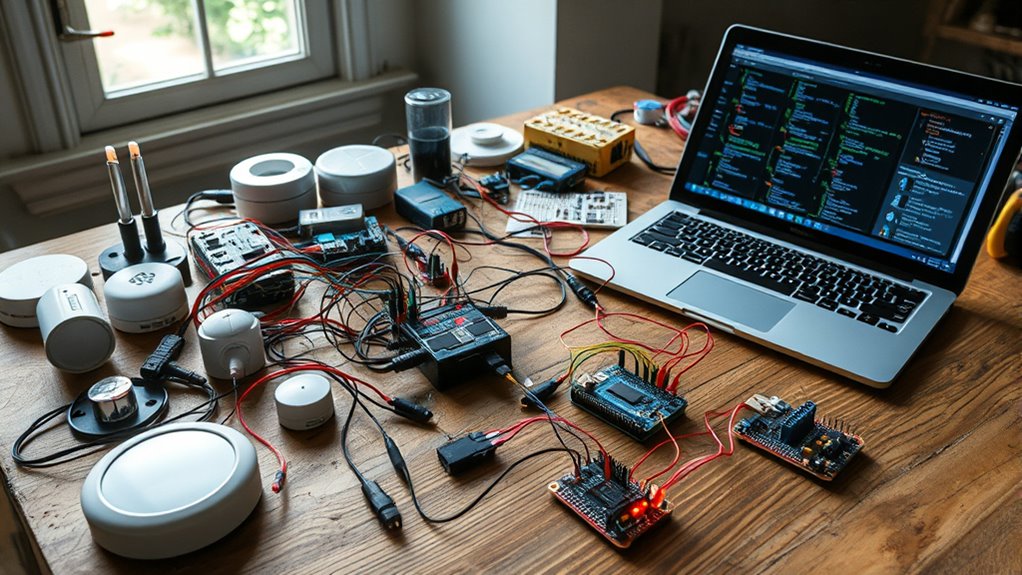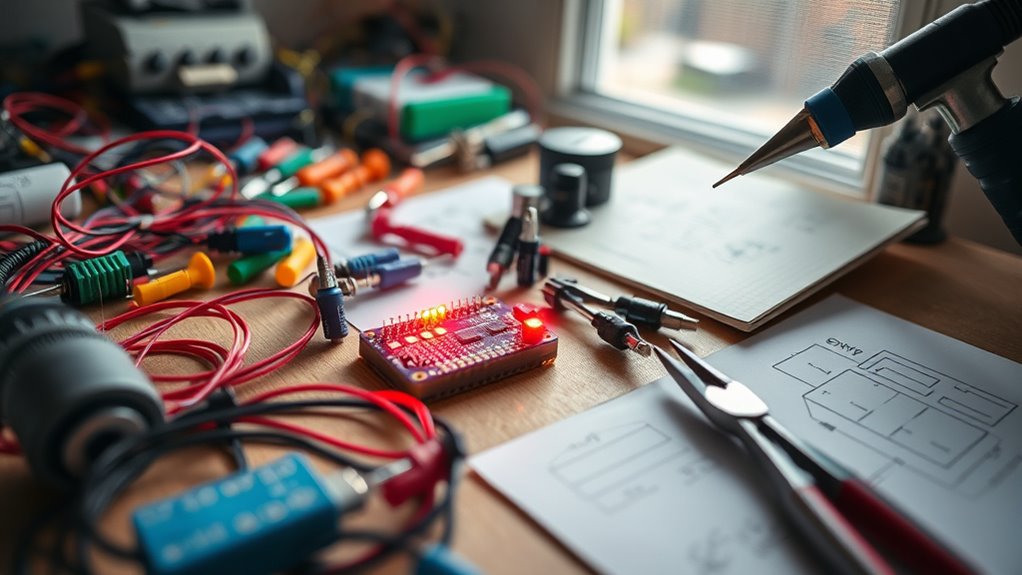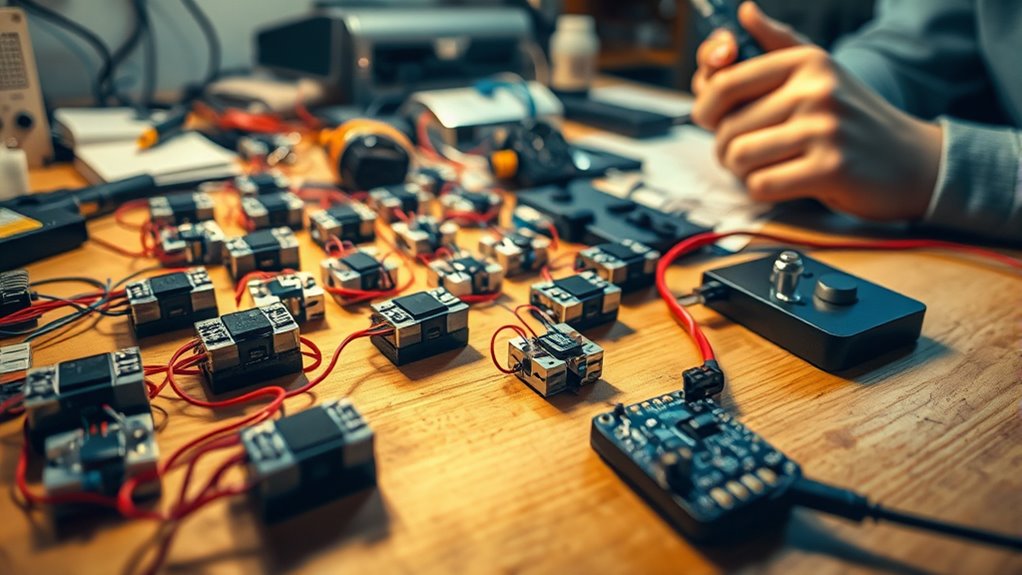To build a DIY home alert network with off-the-shelf sensors, start by choosing sensors suited for high-traffic areas, entry points, and fire-prone zones. Gather tools like screwdrivers, mounting hardware, and compatible power sources. Connect sensors to a central system using reliable protocols like Wi-Fi or Zigbee, and program customized alerts for different events. Regularly test and maintain your system to guarantee reliable performance. If you keep going, you’ll find tips to make your setup more effective and secure.
Key Takeaways
- Select suitable off-the-shelf sensors for specific home areas, focusing on reliability and false alarm reduction.
- Gather necessary tools, mounting hardware, and compatible power sources for secure installation.
- Connect sensors to a central hub using reliable protocols like Wi-Fi, Zigbee, or Z-Wave, ensuring secure communication.
- Program customized alerts and notifications based on sensor thresholds and preferred communication channels.
- Regularly test, calibrate, and maintain sensors to ensure ongoing accuracy and system reliability.
Selecting the Right Sensors for Your Home Safety Needs

Choosing the right sensors is essential to creating an effective home alert network. Proper sensor placement guarantees you cover important areas without gaps, maximizing safety. Think about high-traffic zones, entry points, and areas prone to fire or smoke. When selecting sensors, look for models with false alarm reduction features to avoid unnecessary alerts caused by pets, steam, or dust. This helps you trust your system and reduces nuisance alarms. Also, consider environmental factors like humidity or temperature, which can affect sensor performance. By carefully choosing sensors suited to each area and understanding their placement, you’ll build a reliable network that alerts you promptly while minimizing false alarms. This thoughtful approach keeps your home safe and your alerts accurate. Incorporating sensor technology with advanced detection capabilities can further enhance system reliability.
Gathering the Necessary Tools and Components

Before you start assembling your home alert network, it’s important to gather all the necessary tools and components. First, identify the sensors you plan to use, considering sensor placement to maximize coverage and effectiveness. You’ll need mounting hardware, such as screws or adhesive strips, to secure sensors in ideal locations. Don’t forget power sources—batteries or adapters—to keep your sensors operational. Check that your sensors are compatible with your monitoring system and have the required connectors or cables. Having spare batteries on hand ensures continuous operation. Additionally, gather basic tools like a drill, screwdriver, and wire cutters. Preparing these supplies beforehand helps streamline installation, guarantees reliable sensor placement, and maintains a steady power supply for your DIY home alert network. Understanding sensor technology can also help you choose the most suitable sensors for your specific needs.
Connecting Sensors to a Central Monitoring System

How do you guarantee your sensors communicate effectively with your central monitoring system? First, ensure proper sensor calibration so readings are accurate, reducing false alarms. Regular calibration helps maintain reliability and trust in your data. Next, focus on power management; choose sensors with low power consumption or those that support sleep modes to extend battery life. Use reliable communication protocols like Wi-Fi, Zigbee, or Z-Wave, depending on your setup, to ensure seamless data transfer. Keep connections secure with encryption to prevent interference or hacking. Proper placement also matters—install sensors where they can effectively detect changes without obstructions. Additionally, implementing robust communication protocols can enhance data integrity and reduce transmission errors. By combining accurate calibration, efficient power management, and solid communication protocols, you create a dependable link between your sensors and your central system.
Programming Alerts and Notifications

Once your sensors are properly calibrated and communicating reliably with your central system, setting up effective alerts and notifications makes certain you’re promptly informed of any issues. You can customize alerts based on sensor data thresholds, ensuring you’re only notified when necessary. Alert customization allows you to prioritize critical issues and reduce false alarms. Use your system’s interface to define specific conditions, such as temperature spikes or water leaks, and set notification preferences—email, SMS, or app alerts. Proper programming guarantees quick response times and minimizes disturbances. Remember, clear thresholds and tailored alerts help avoid alarm fatigue. Here’s a quick overview of key alert options:
| Condition | Notification Type | Priority Level |
|---|---|---|
| Temperature spike | High | |
| Water leak detected | SMS | Critical |
| Motion detection | App push | Medium |
| Sensor malfunction | Low | |
| Battery low | App push | Medium |
Additionally, implementing Vetted alert systems ensures your notifications are reliable and trustworthy, reducing the chance of missed or false alarms.
Testing and Maintaining Your DIY Alert Network

Are you confident that your DIY alert network is functioning reliably? Regular testing is essential to ensure sensors respond accurately. Start by calibrating each sensor to maintain sensor calibration, which helps detect true events and reduces false alarms. Test sensors individually by triggering their specific conditions and verifying notifications or alarms. Don’t forget to review and update your alarm customization settings so alerts remain relevant and avoid unnecessary disruptions. Periodic maintenance, like cleaning sensors and checking wiring, keeps your system in top shape. Document your tests and adjustments to track performance over time. Incorporating sound design principles into your alert notifications can improve their clarity and effectiveness. This ongoing effort helps you catch issues early, keeps your system reliable, and guarantees it provides the protection you need.
Frequently Asked Questions
Can I Integrate My Existing Smart Home Devices Into This Alert System?
You can usually integrate your existing smart home devices into this alert system, but it depends on sensor compatibility and device interoperability. Check if your devices support common protocols like Z-Wave, Zigbee, or Wi-Fi. If they do, you can connect them seamlessly. Otherwise, you might need a hub or bridge to enable communication. Ensuring compatibility upfront helps create a unified, efficient alert network that works with your current smart home setup.
What Is the Estimated Cost for Building a Comprehensive DIY Alert Network?
When estimating the cost of a detailed DIY alert network, you should focus on budget planning and hardware selection. Your expenses depend on the sensors, controllers, and accessories you choose, with off-the-shelf options offering affordable solutions. Expect to spend anywhere from $100 to several hundred dollars. Carefully compare products, consider your needs, and allocate funds accordingly to build an effective system without overspending.
How Secure Is the Data Transmitted Between Sensors and the Central System?
You might wonder about the security of data transmitted between sensors and your central system. Typically, wireless protocols like Wi-Fi, Zigbee, or Z-Wave use data encryption to protect your information from interception. While these protocols offer good security, it’s essential to keep your firmware updated and use strong passwords to prevent unauthorized access. Regularly reviewing your network’s security settings helps guarantee your data stays private and secure.
Are There Any Legal Considerations or Privacy Concerns When Deploying Sensors?
Like a locked vault guarding secrets, deploying sensors raises questions about privacy regulations and data ownership. You must guarantee your setup complies with local laws, respecting others’ privacy. Be transparent about what data you collect and how you use it. Obtain necessary permissions, and secure sensitive information. Respecting legal boundaries keeps your home alert network trustworthy and avoids potential legal pitfalls, safeguarding both your privacy and peace of mind.
How Can I Expand or Upgrade the System in the Future?
To expand or upgrade your system, focus on regular sensor calibration to guarantee accuracy and reliability. Consider upgrading sensors with newer models for better features or coverage. Improve power management by adding options like rechargeable batteries or solar panels, especially for outdoor sensors. As you scale, integrate additional sensors or smart devices to enhance detection and automation, making your home smarter and more secure over time.
Conclusion
By now, you’ve got the basics to build your own home alert network with off-the-shelf sensors. With the right setup, you can keep your home safe and respond quickly to emergencies. Are you ready to take control and customize your system to fit your needs? Remember, a well-maintained and thoughtfully designed network isn’t just about technology—it’s about peace of mind, knowing you’re doing everything possible to protect what matters most.











